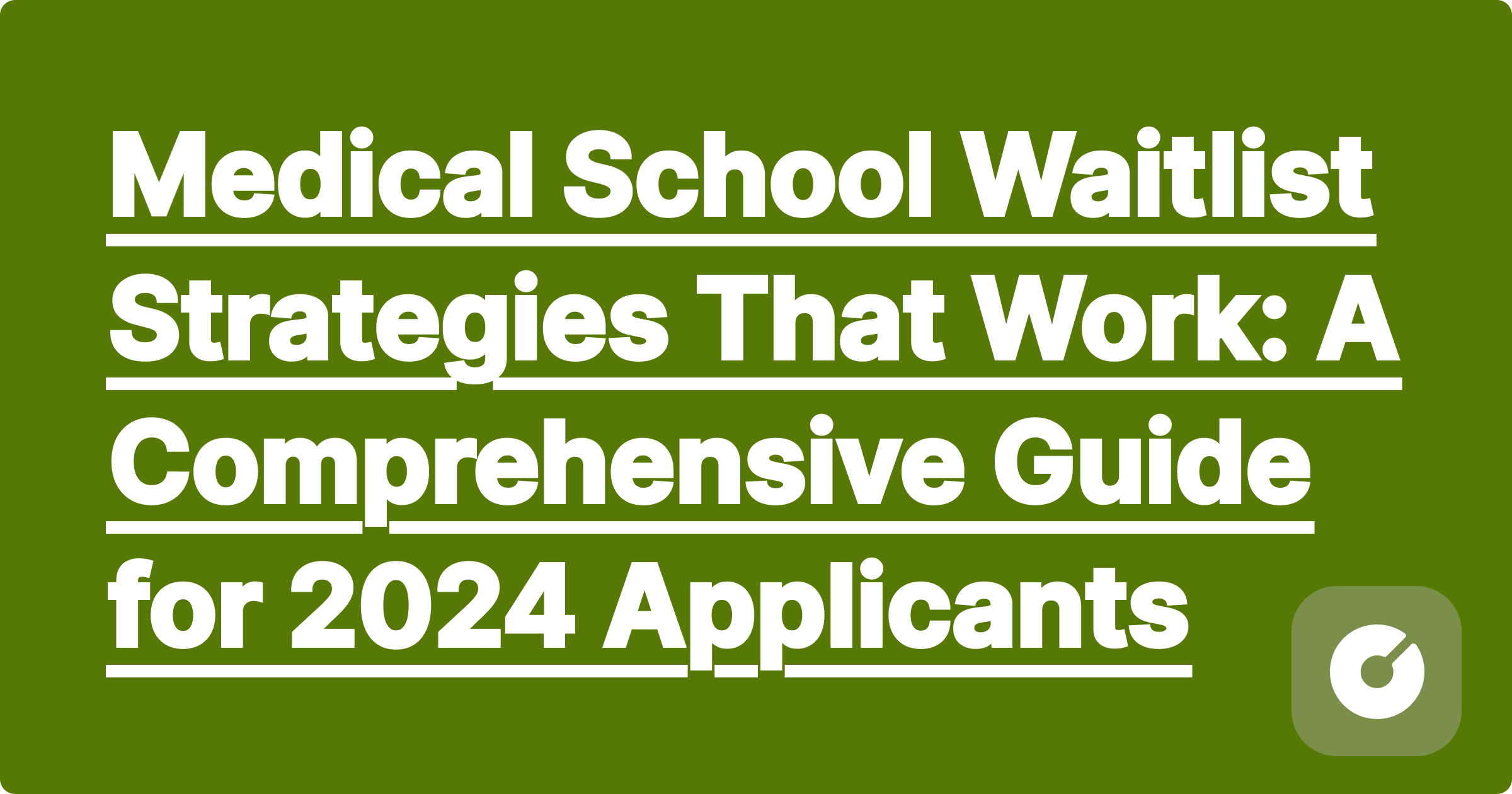
The medical school application process is notoriously competitive. Even with stellar MCAT scores and GPAs, many highly qualified applicants find themselves on the waitlist. While receiving a waitlist notification can feel devastating, it's crucial to remember it's not a rejection. It means the admissions committee sees potential in your application, but needs more time or space to make a final decision. This comprehensive guide outlines effective strategies to improve your chances of acceptance from the waitlist in 2024.
Unfortunately, precise, publicly available waitlist statistics for 2024 are not readily compiled by a central authority. Data is often institution-specific and not released until well after the admissions cycle concludes. However, we can glean insights from previous years' trends:
High Competitiveness: The number of applicants significantly outpaces available medical school seats, resulting in a larger pool of waitlisted candidates each year. Acceptance rates from waitlists vary widely, typically ranging from 5% to 30%, depending on the school and the strength of the applicant pool.
Factors Influencing Waitlist Decisions: While initial application strength is key, factors like subsequent achievements, updated letters of recommendation, and demonstrated continued interest significantly influence waitlist movement.
Financial Considerations: Understanding the financial implications of remaining on the waitlist—including application fees, potential tuition deposits, and housing costs—is crucial.
Moving from the waitlist to acceptance requires a proactive and strategic approach. Here's a breakdown of effective strategies:
The LOCI is your opportunity to reiterate your commitment and address any potential concerns the admissions committee might have. Avoid simply restating your application. Focus on:
New Achievements: Highlight any significant accomplishments since submitting your application, such as research publications, volunteer work, shadowing experiences, or leadership roles. Quantify your contributions whenever possible. For example, instead of "Volunteered at a local clinic," write "Volunteered 100 hours at [Clinic Name], assisting with patient intake and providing administrative support."
Addressing Concerns (Subtly): If you received any feedback (directly or indirectly), address it thoughtfully. For instance, if your MCAT score was slightly below average, highlight subsequent improvements in your academic performance or relevant experiences that demonstrate your capabilities.
Reiterating Commitment: Re-emphasize your unwavering interest in the specific medical school and its mission. Demonstrate you've researched recent developments, faculty work, and community initiatives.
Professionalism and Brevity: Keep your LOCI concise, professional, and error-free. Aim for a one-page letter.
Example: "Since submitting my application, I've published a research paper on [topic] in the [journal name], further solidifying my commitment to [research area]. This experience reinforced my interest in [specific medical school's research program] and its alignment with my long-term career goals."
Depending on the school's instructions, you might be able to submit updated materials, such as:
Updated Transcripts: If you've completed additional coursework since your application submission, provide updated transcripts.
New Letters of Recommendation: A strong letter from a new mentor or professor showcasing recent accomplishments could significantly strengthen your application.
New MCAT Score (If Applicable): If you retook the MCAT and achieved a higher score, immediately inform the admissions committee.
Going beyond the LOCI showcases your genuine enthusiasm. Consider:
Visiting the Campus (If Possible): A campus visit demonstrates your serious interest and allows you to connect with faculty or current students.
Networking with Faculty: Reach out to professors whose research interests align with yours. A brief email expressing your continued interest can make a difference.
Following the School on Social Media: Engage with the school's social media platforms to show you're staying informed about their activities.
Being on the waitlist often extends the application process, leading to additional costs:
Application Fees (if applicable): Some schools may require additional fees for waitlist consideration.
Tuition Deposits: If you're accepted from the waitlist, you'll likely need to pay a tuition deposit promptly, which could be substantial (ranging from $1,000 to $5,000 or more depending on the institution).
Housing and Living Expenses: If you're accepted late, securing housing may be challenging and costly.
While actively pursuing acceptance from the waitlist, acknowledge that there's no guarantee. Prepare for other possibilities:
Alternative Medical Schools: Continue engaging with other medical schools you applied to or consider applying to others for future cycles.
Gap Year Activities: Use any time before the next application cycle productively to strengthen your application further.
Sarah was waitlisted at her top-choice medical school, University of California, San Francisco (UCSF). Knowing UCSF's average MCAT score is around 518 and GPA is 3.8, Sarah felt disheartened despite her 515 MCAT and 3.7 GPA. She wrote a compelling LOCI highlighting her recent publication in a peer-reviewed journal, a new volunteer leadership role, and re-emphasized her interest in UCSF's renowned cardiology program. She also visited the campus and connected with a faculty member whose research aligned with her interests. Her proactive approach ultimately led to her acceptance from the waitlist.
The medical school waitlist process is challenging but not insurmountable. By implementing these strategies, you significantly increase your chances of acceptance. Remember to remain proactive, persistent, and professional throughout the process. Good luck!
(Note: Specific 2024 acceptance rates and GPA/MCAT averages for individual medical schools are not readily available publicly at this time. This information is subject to change and should be verified directly with the respective institutions.)
Second Career Medical Students: Changing Paths to a Rewarding Career
Foreign Medical Schools for US Students: A Comprehensive Guide for 2024 and Beyond
Osteopathic Medicine: Growing Acceptance and Benefits for Aspiring Physicians
Joint Degree Programs: MD/MBA, MD/JD, MD/MPH – Your Path to a Multifaceted Career in Medicine
Medical School Housing: On-Campus vs. Off-Campus – A Comprehensive Guide for 2024 & Beyond
Physician Assistant vs. Medical School: A 2024 Decision Guide for Pre-Med Students
International Medical Graduate (IMG) Path to US Practice: A Comprehensive Guide for 2024
Caribbean Medical Schools: A Comprehensive Alternative Path Analysis for 2024
Medical School Study Strategies That Top Students Use: Ace Your Exams and Thrive
Navigating the Path to Medical School: A Comprehensive Guide to Early Assurance Programs